- Heat guard Victor Oladipo had a successful season-ending surgery on the pesky right quadriceps tendon that he initially injured in 2019, per a team press release. A timeline for his return has not been disclosed, but he’ll miss the entire 2020/21 postseason. Oladipo will be an unrestricted free agent this summer and his checkered injury history figures to hurt his value.
Heat guard Victor Oladipo will undergo surgery on the same right quadriceps tendon that he ruptured in 2019, the team announced today (via Twitter). The procedure will end Oladipo’s season and there’s no timetable for his return, per the club.
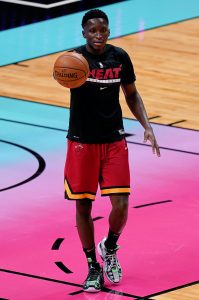 It’s a disappointing turn of events for Oladipo and for the Heat, who acquired the two-time All-Star at the trade deadline in March. However, if there’s a belief that going under the knife again represents Oladipo’s best path back to full strength, it’s the right call.
It’s a disappointing turn of events for Oladipo and for the Heat, who acquired the two-time All-Star at the trade deadline in March. However, if there’s a belief that going under the knife again represents Oladipo’s best path back to full strength, it’s the right call.
According to Tim Reynolds of The Associated Press (Twitter link), Oladipo made the decision himself to undergo surgery, but the Heat were in agreement. A source tells Barry Jackson of The Miami Herald (Twitter link) that the quad tendon isn’t ruptured this time around, so there’s hope that Oladipo’s recovery will be quicker than it was in 2019-20.
Oladipo, who returned from his previous quad tendon injury in January of 2020, never seemed to fully recapture his old All-Star form during the last year. In 33 games this season for the Pacers, Rockets, and Heat, the 29-year-old posted respectable marks of 19.8 PPG, 4.8 RPG, and 4.6 APG, but his shooting averages (.408/.326/.754) were well below his career numbers and he didn’t look as explosive as he had during his first two years in Indiana.
With Oladipo unavailable going forward, the Heat will continue to rely on a backcourt rotation headed by Tyler Herro, Kendrick Nunn, and Goran Dragic.
As for Oladipo, he’s on track to become an unrestricted free agent this offseason and his stock will certainly be affected by this development. Teams interested in signing Oladipo will keep a close eye on his recovery process, and it seems possible he’ll end up on a short-term deal that would allow him to try to rebuild his value before he returns to the open market in a year or two.
Photo courtesy of USA Today Sports Images.
- The Heat have seen a performative uptick lately, despite several backcourt absences. Anthony Chiang of the Miami Herald takes a look at how the in-season additions of veterans Trevor Ariza and Dewayne Dedmon, both 2021 unrestricted free agents, have benefited Miami. Ariza, 35, has started in 24 of the 27 games he has appeared in with the Heat, during which the team went 15-12. In a smaller but still crucial role as the team’s reserve big man willing to do the dirty work on defense, Dedmon has averaged 13.5 MPG across his 13 appearances with Miami — the club has gone 9-4 in those games.
- Victor Oladipo (knee) still isn’t traveling with the Heat on their current road trip, but the recent return of Tyler Herro to the backcourt has given the team a boost, writes Khobi Price of The Sun Sentinel.
When Kevin O’Connor of The Ringer shared his early All-NBA picks this week, he rightly pointed out that limiting the field to 15 players will leave a number of worthy candidates on the outside looking in. O’Connor had to exclude worthy contenders such as Devin Booker, Zion Williamson, Jaylen Brown, Ben Simmons, Jimmy Butler, Russell Westbrook, Trae Young, Jrue Holiday, and Kyrie Irving from his three All-NBA teams.
Among the other players left off the top 15 by O’Connor were Donovan Mitchell, Zach LaVine, Bam Adebayo, and De’Aaron Fox. Those players are especially notable because an All-NBA spot this season would either substantially increase the value of the contract extensions they signed last offseason or would put them in line for a significantly more lucrative extension this summer.
Jayson Tatum, who earned a spot on O’Connor’s All-NBA Third Team, is in the same boat. Like Mitchell, Adebayo, and Fox, he signed a rookie scale extension that includes Rose Rule language, which could bump his starting salary from 25% of the cap to 30% of the cap.
Here are how those players, who signed five-year, maximum-salary contract extensions last offseason, will be affected by whether or not they earn All-NBA honors. These are projected values based on a 3% salary cap increase.
| Player | No All-NBA | All-NBA |
|---|---|---|
| Donovan Mitchell | $163,000,590 | $195,600,710 |
| Jayson Tatum | $163,000,590 | $195,600,710 |
| Bam Adebayo | $163,000,590 | $185,820,675 (First Team only) |
| De’Aaron Fox | $163,000,590 | $169,522,180 (Third Team) * |
* Fox’s deal would be worth $182,560,660 if he makes the All-NBA Second Team and $195,600,710 if he makes the First Team.
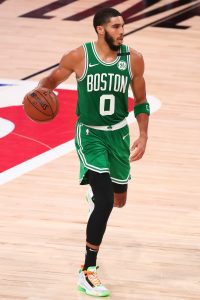 Fox probably has no chance at making an All-NBA team, given the competition at guard and the Kings’ spot in the standings. The other three players here have better cases, but Adebayo is likely a long shot, making Mitchell and Tatum the most realistic candidates. They’d only need to sneak onto the Third Team to increase the projected value of their new five-year deals by more than $32MM.
Fox probably has no chance at making an All-NBA team, given the competition at guard and the Kings’ spot in the standings. The other three players here have better cases, but Adebayo is likely a long shot, making Mitchell and Tatum the most realistic candidates. They’d only need to sneak onto the Third Team to increase the projected value of their new five-year deals by more than $32MM.
As O’Connor writes, Tatum has a clearer path to an All-NBA spot than Mitchell based on his position. The guard spot is absolutely stacked this season — Mitchell would have to beat out at least one of Luka Doncic, Stephen Curry, Damian Lillard, Chris Paul, Bradley Beal, and James Harden, as well as all the guards mentioned at the top of this story. As good as he’s been, he may be left out.
While Tatum, Mitchell, Adebayo, and Fox have already negotiated “super-max” language into their contracts and are now trying to guarantee a salary increase by earning All-NBA honors, a handful of players will become eligible for a higher maximum salary on a new extension if they make an All-NBA team this year. An All-NBA spot would either make them eligible for a Rose Rule extension or a Designated Veteran Extension.
Here are those players, along with the projected contract extension they’d become eligible for with an All-NBA nod. These projections are on the conservative side, since they’re based on annual salary cap increases of just 3%.
| Player | Max extension with All-NBA spot |
Year it would begin |
|---|---|---|
| Nikola Jokic |
Five years, $242,098,25 | 2023/24 * |
| Joel Embiid |
Four years, $187,000,032 | 2023/24 |
| Zach LaVine |
Five years, $235,046,855 | 2022/23 |
| Luka Doncic | Five years, $201,468,730 | 2022/23 |
* Jokic would have to wait until the 2022 offseason to sign a super-max extension. The others could sign extensions during the 2021 offseason.
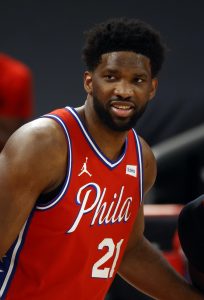 Embiid is still under contract for two more years beyond 2020/21, which is why he’d only be able to tack on four new years to his current deal instead of five. Jokic is in a similar spot, but because he’ll only have six years of NBA service at the end of this season, he’d have to wait until 2022 to officially sign an extension, at which point he’d be eligible for five new years instead of just four.
Embiid is still under contract for two more years beyond 2020/21, which is why he’d only be able to tack on four new years to his current deal instead of five. Jokic is in a similar spot, but because he’ll only have six years of NBA service at the end of this season, he’d have to wait until 2022 to officially sign an extension, at which point he’d be eligible for five new years instead of just four.
Doncic’s potential extension has the lowest average value of any of these hypothetical deals because he’d only be eligible for a starting salary worth 30% of the cap, instead of 35%, due to his limited years of NBA service.
MVP candidates Jokic, Embiid, and Doncic all look like pretty safe bets to make an All-NBA team this spring, and I imagine the Nuggets, Sixers, and Mavericks will be ready to put super-max extension offers on the table for their respective stars as soon as they’re eligible to sign them.
As for LaVine, he likely won’t make an All-NBA team, which may be a relief for the Bulls — deciding whether or not to offer LaVine a standard maximum contract could be a difficult decision in its own right. If he were eligible for a super-max, that would make negotiations even more challenging.
Assuming LaVine doesn’t earn All-NBA honors, he’d only be eligible for a four-year, $104.83MM extension this offseason. However, the Bulls could go higher than that if they renegotiate his 2021/22 salary using their cap room, or if they wait until the 2022 offseason — as a free agent, LaVine would be eligible for a five-year contract worth up to $201.47MM (projection based on 3% annual cap increases) if he re-signs with Chicago, even without All-NBA honors.
Photos courtesy of USA Today Sports Images.
Throughout the season, Hoops Rumors takes a closer look at players who will be free agents or could become free agents this off-season. We examine if their stock is rising or falling due to performance and other factors. This week, we take a look at players from the Southeast Division:
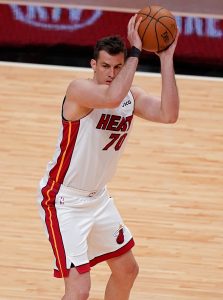 Nemanja Bjelica, Heat, 32, PF (Down) – Signed to a three-year, $20.5MM deal in 2018
Nemanja Bjelica, Heat, 32, PF (Down) – Signed to a three-year, $20.5MM deal in 2018
There was a lot of bellyaching in Sacramento this season when Bjelica’s minutes were basically handed to Marvin Bagley III, as the Kings evaluated whether to make the 2018 No. 2 overall pick part of their long-term plans. Bjelica didn’t play for a month until injuries forced the Kings’ hands in February. He got a fresh start with Miami when it acquired him at the trade deadline. It hasn’t worked out.
Bjelica has been a non-factor while playing spot minutes. His 3-point shooting has tanked without steady playing time and that’s his top asset. Bjelica might wind up back in Europe unless he’s willing to accept a second-unit role at a much lower salary than he’s made the last three seasons.
Daniel Gafford, Wizards, 22, PF/C (Up) – Signed to a four-year, $6.1MM deal in 2019
When NBA analysts look at which trade deadline acquisitions have made the biggest impact, no one would have guessed that Gafford would be at or near the top of the list. He’s limited offensively but on his best nights, he’s a ferocious rebounder and shot-blocker.
Gafford is averaging 10.4 PPG, 5.9 RPG and 2.0 BPG in 17.9 MPG for a team that has been decimated by frontcourt injuries. His $1.78MM salary for next season doesn’t fully guarantee until next January. The Wizards hold a $1.93MM option on the 2022/23 season. Rest assured, Washington will keep Gafford around.
John Collins, Hawks, 23, PF (Up) – Signed to a four-year, $11MM deal in 2017
Collins could be the most intriguing free agent on the market this summer. The Hawks can make him a restricted free agency by extending him a $7.7MM qualifying offer. That’s a safe assumption. From there, things will get very interesting. Collins’ name was bandied about in trade rumors this winter – he reportedly turned down a $90MM extension offer with the hope of getting the max, or something close to it, in restricted free agency. Does any other team value Collins as a max-type player? We’ll find out when the market opens.
James Ennis, Magic, 30, SF (Down) – Signed to a one-year, $3.33MM deal in 2020
The Magic brought back Ennis on a one-year deal for a team with playoff aspirations. Ennis was a starter the first half of the season until the front office decided to hit the reset button. With Orlando in total rebuild mode, Ennis will be seeking a new team this summer.
With the Magic focusing on their youth, Ennis hasn’t played this month, supposedly due to a sore calf. He’s passed through seven teams during his seven seasons in the league. Ennis will likely be looking at a one-year, veteran’s minimum deal for a club seeking insurance at small forward.
Photo courtesy of USA Today Sports Images.
Earlier in the week, we noted that a fascinating race is shaping up in the 5-7 range of the Western Conference and asked whether you expect the Mavericks, Lakers, or Trail Blazers to finish in the seventh spot, making them subject to at least one play-in game.
While it may not have a narrative as compelling as the defending champions being forced to participate in a play-in tournament, the Eastern Conference is also producing a fascinating race in the 4-7 range.
Currently, the Knicks (37-29) control the No. 4 seed, followed by the Hawks (37-31) at No. 5. The Celtics and Heat are in a dead heat for sixth place, though their 35-31 records mean they’re actually tied with Atlanta in the loss column.
New York and Atlanta were among the Eastern Conference’s bottom-feeders a year ago, whereas Boston and Miami met in the 2020 Eastern Finals and entered the season expecting to be among the top five teams in the conference again. Now it seems very possible that either the Celtics or Heat will finish at No. 7 and host the first play-in game.
Here are the four teams’ remaining schedules:
- Knicks: at PHX, at LAC, at LAL, vs. SAS, vs. CHA, vs. BOS (one back-to-back)
- Hawks: vs. WSH, vs. WSH, vs. ORL, vs. HOU (one back-to-back)
- Celtics: at CHI, vs. MIA, vs. MIA, at CLE, at MIN, at NYK (two back-to-backs)
- Heat: vs. MIN, at BOS, at BOS, vs. PHI, at MIL, at DET (one back-to-back)
Although the Knicks have the most room for error, they also have the most challenging schedule of these four Eastern teams, especially if LeBron James and Anthony Davis are available for the Lakers in the final game of that West Coast road trip. The Knicks will finish their season with three games at home, but all three of their opponents in those games will be competing all-out for playoff positioning.
As hot as Washington has been, the Hawks easily have the most favorable remaining schedule of these four teams, with only four games left, including a pair against bottom-five teams in the NBA, Orlando and Houston. They’re in good position to clinch a top-six seed, especially if they win at least once vs. the Wizards.
The two upcoming games between the Celtics and Heat loom large in the race to avoid the play-in. Boston is 1-0 against Miami so far this season and will host both of those games, giving the Celtics the upper hand to clinch the tiebreaker and stay ahead of Pat Riley‘s club in the standings.
The fact that the Heat will follow up those two games vs. the Celtics by playing Philadelphia and Milwaukee while the C’s take on Cleveland and Minnesota further tilts the scales in Boston’s favor, though Jimmy Butler doesn’t sound worried about the Heat’s schedule.
One factor working in the Heat’s favor is that they hold a tiebreaker edge over the Knicks (but not Atlanta). The Celtics, meanwhile, are the only one of the four teams with two back-to-back sets, which may hurt them a little.
What do you think? Will the defending Eastern Conference champs end up in the No. 7 seed, taking part in the play-in tournament, or will they be able to pass one of the teams above them to clinch a top-six spot?
Vote in our poll, then head to the comment section below to share your thoughts!
Trade Rumors app users, click here to vote.
The NBA’s rookie scale, which determines how much first-round picks earn during their first four NBA seasons, also dictates how much the qualifying offers will be worth for those players when they reach restricted free agency after year four. However, the value of those qualifying offers can fluctuate depending on whether or not a player has met the “starter criteria.”
Here’s how the starter criteria works in a typical year:
- A player who is eligible for restricted free agency is considered to have met the starter criteria if he plays at least 2,000 minutes or starts 41 games in the season before he reaches free agency.
- A player can also meet the criteria if he averages either of those marks in the two seasons prior to his restricted free agency. For instance, if a player started 50 games one year and 32 the next, he’d meet the starter criteria, since his average number of starts over the last two seasons is 41.
The thresholds for the starter criteria this year are a little different due to the truncated nature of the last two NBA seasons. The 41-start and 2,000-minute thresholds are prorated and are based on the pre-bubble games in 2019/20 and a 72-game schedule in 2020/21.
In other words, if a player’s team played 64 games prior to the summer restart last season, he’d need to compile 68 starts across the two seasons (half of 136 games) to meet the criteria. This proration applies to a player’s minutes total as well.
A player’s ability or inability to meet the starter criteria can affect the value of the qualifying offer he receives as a restricted free agent, as follows:
- A top-14 pick who does not meet the starter criteria will receive a qualifying offer equal to the amount the 15th overall pick would receive if he signed for 120% of the rookie scale.
- A player picked between 10th and 30th who meets the criteria will receive a qualifying offer equal to the amount the ninth overall pick would receive if he signed for 120% of the rookie scale.
- A second-round pick or undrafted player who meets the criteria will receive a qualifying offer equal to the amount the 21st overall pick would receive if he signed for 100% of the rookie scale.
- For all other RFAs, the standard criteria determine the amounts of their qualifying offers.
Extending a qualifying offer to a player eligible for restricted free agency officially makes that player an RFA, ensuring that his team has the right of first refusal if he signs an offer sheet with another club. It also gives the player the option of signing that one-year QO.
Generally, the value of a restricted free agent’s qualifying offer isn’t hugely important, since very few RFAs accept those offers outright. There are exceptions though.
Last offseason, for instance, Denzel Valentine failed to meet the starter criteria heading into restricted free agency, reducing the value of his qualifying offer to $4,642,800. The Bulls decided to issue that qualifying offer and he accepted it.
Had he met the starter criteria and been eligible for a slightly larger QO, Valentine’s free agency could have played out differently, as Kris Dunn‘s did — Dunn met the starter criteria, increasing the value of his QO, and Chicago opted not to give him a QO, making him an unrestricted free agent.
Top-14 picks who failed to meet starter criteria:
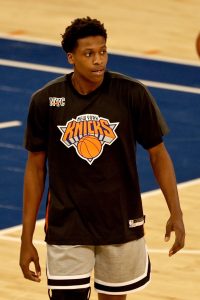 With all that in mind, let’s check in on how this year’s RFAs-to-be will be impacted by the starter criteria. Listed below are the former top-14 picks on track for restricted free agency who have not met the starter criteria. These players will be eligible for qualifying offers worth $7,031,451.
With all that in mind, let’s check in on how this year’s RFAs-to-be will be impacted by the starter criteria. Listed below are the former top-14 picks on track for restricted free agency who have not met the starter criteria. These players will be eligible for qualifying offers worth $7,031,451.
- Frank Ntilikina (Knicks)
- Dennis Smith Jr. (Pistons)
- Zach Collins (Trail Blazers)
- Malik Monk (Hornets)
Half of the players selected in the top 14 of the 2017 draft signed rookie scale extensions in 2020, meaning they won’t have to worry about the value of their qualifying offers this offseason. Of the other seven, the four players listed above failed to meet the criteria.
Even with the lower qualifying offers, some of these players – including Ntilikina and Smith – may not receive QOs at all, making them unrestricted free agents.
Lonzo Ball (Pelicans) and Lauri Markkanen (Bulls) each met the starter criteria, securing potential QOs of $14.36MM and $9.03MM, respectively. Josh Jackson was the only top-14 pick from ’17 who was waived before completing his rookie contract — since he’s on a new contract now, the starter criteria doesn’t apply to him.
First-round picks between 10-30 who met starter criteria:
A pair of players fall into this group this season, and will now be eligible for a qualifying offer worth $7,705,447.
- John Collins (Hawks)
- Jarrett Allen (Cavaliers)
As a result of meeting the starter criteria, Collins’ qualifying offer will increase from $5,899,793, while Allen’s get a bump from $5,661,538. It’s unlikely to matter a whole lot for either player though, since they’re both strong candidates to sign lucrative long-term deals and almost certainly won’t give any real consideration to accepting their respective QOs.
Pelicans wing Josh Hart, the 30th overall pick in 2017, was the strongest candidate to join Collins and Allen in this group, but will fall short of meeting the criteria due in large part to the thumb injury that has sidelined him since April 1. If Hart had played the Pelicans’ last 19 games and maintained his minutes per game average for the season (28.7 MPG), he would’ve passed the required minutes threshold by now.
Second-round picks and UDFAs who met starter criteria:
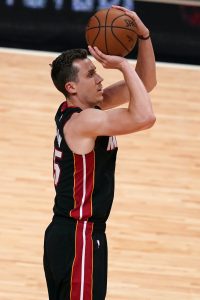 The players listed below signed as second-round picks or undrafted free agents, but have met the starter criteria and are now eligible for a qualifying offer worth $4,736,102.
The players listed below signed as second-round picks or undrafted free agents, but have met the starter criteria and are now eligible for a qualifying offer worth $4,736,102.
- Bruce Brown (Nets)
- Devonte’ Graham (Hornets)
- Kendrick Nunn (Heat)
- Duncan Robinson (Heat)
- Gary Trent Jr. (Raptors)
Brown, Graham, Nunn, Robinson, and Trent are all on minimum-salary contracts and would’ve had very modest QOs (in the $2MM range) if they hadn’t met the starter criteria. Even after the bump to $4.74MM though, most or all of them will end up signing more lucrative contracts.
Among other second-round picks and undrafted free agents, two who came close to meeting the starter criteria are Isaac Bonga (Wizards) and Jarred Vanderbilt (Timberwolves).
After starting 41 games of 64 pre-bubble games a year ago, Bonga needed to make 27 starts this season, but has only started eight games for Washington to date. As for Vanderbilt, he needed 36 starts in 2020/21 to bump the value of his QO — he recorded his 25th start on March 26, but hasn’t been in Minnesota’s starting five since then.
Bonga, Vanderbilt, and the rest of this year’s restricted free agents, won’t have their projected qualifying offers impacted by the starter criteria.
Photos courtesy of USA Today Sports Images.
- In what has become an annual tradition, Heat center Udonis Haslem said this week that he’s unsure whether or not he’ll play another year and that he plans to make that decision sometime after the season (Twitter link via Ira Winderman of The South Florida Sun Sentinel). The big man, who will turn 41 next month, has signed one-year contracts with Miami for five consecutive years.
- Goran Dragic appears to be peaking at the right time again for the Heat, Ira Winderman of the South Florida Sun Sentinel writes. Dragic, who shined in the postseason last summer, has scored 18 points in two of his past three games. “I’m getting there, I’m getting there,” he said. “You know, still working on my confidence and everything. But the last few games, I feel awesome, my legs were there, I was running the ball more.”